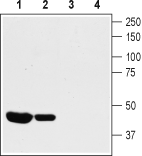Overview
- Peptide (C)KDPETLLPTNDIHR, corresponding to amino acid residues 187-200 of human KV1.8 (Accession Q16322). Intracellular, N-terminus.

 Western blot analysis of rat (lanes 1 and 3) and mouse (lanes 2 and 4) heart lysates:1,2. Anti-KV1.8 Antibody (#APC-157), (1:800).
Western blot analysis of rat (lanes 1 and 3) and mouse (lanes 2 and 4) heart lysates:1,2. Anti-KV1.8 Antibody (#APC-157), (1:800).
3,4. Anti-KV1.8 Antibody, preincubated with Kv1.8 Blocking Peptide (#BLP-PC157).
Potassium (K+) channels regulate cell membrane potential and modulate a number of important cellular functions. K+ voltage-gated channel subfamily A member 10 (KCNA10) also known as KV1.8 is a voltage-gated K+ (KV) channel gene related to the Shaker family of K+ channels that includes eight members (KV1.1- KV1.8)1. KV1.8 contains six membrane-spanning domains with a shaker-type repeat in the fourth segment and a pore (P) region. Its most distinguishing feature is the presence of a putative cyclic nucleotide-binding (CNB) domain at the COOH terminus2. It is specifically regulated by cGMP and postulated to mediate the effects of substances that increase intracellular cGMP1. The channel displays an unusual inhibitor profile, because in addition to being blocked by classical K+ channel blockers, it is also sensitive to inhibitors of cyclic nucleotide gated cation channel such as verapamil and pimozide3.
KV1.8 is detected in kidney, heart, and aorta by northern blot and postulated to participate in renal K+ metabolism and to regulate vascular tone3. A recent study showed that a null mutation of mouse KCNA10 causes significant vestibular and mild hearing dysfunction4. In addition KCNA10 has been associated with Long QT syndrome (LQTS), an arrhythmogenic disorder characterized by prolongation of the QT interval on electrocardiograms (ECGs)5.
Application key:
Species reactivity key:
Alomone Labs is pleased to offer a highly specific antibody directed against an epitope of rat KV1.8. Anti-KV1.8 Antibody (#APC-157) can be used in western blot analysis. It has been designed to recognize KV1.8 from rat, mouse and human samples.
